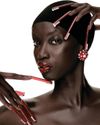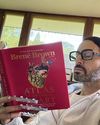
“Sorry about all the kids!” Blake Lively shouts merrily as she staggers under the weight of one child and pulls another along by the hand; a third wanders behind. We are at a terrace restaurant near the top of the Spanish Steps in Rome, and from here we can see the entire city in the slant of evening light, the famous hills and arc of the Tiber river, the marble monuments and ruins tinted pink and blue. Blake’s children are dancing and singing around their mother; it is a scene of joy and silliness and utter chaos, and she seems to be delighting in it. I tell her I’m not going to mention her kids in this piece, and she says oh you can mention them. “Sitting around with them doing chicken dances while I have a very serious conversation with you is probably the most accurate portrait of me possible. Did you bring cookies?” she asks, noticing the bag in my hand. I’d hoped to bake with her in the kitchens of the Rome Sustainable Food Project, which had sent along a batch; Blake is known as a worldclass baker. “So sorry about that,” she says, brushing her hair out of her face. “I’d love to bake with you! But you can see my life….”
I’m not sure I can see her life, but I can sense it: in the sunny kindness in which she sends her children back to their hotel room, in the glee with which she attacks the cookies, in the almost nerdy enthusiasm she projects for Baz Luhrmann and the shoot they just finished for Vogue. Here is the wife of Ryan Reynolds, star of Gossip Girl, The Sisterhood of the Traveling Pants, The Age of Adaline, and A Simple Favor—the sequel to which has brought her here to Rome. (She also has a new movie, It Ends With Us, out in August.) Here she is talking about Luhrmann not as a celebrity might but as the teenage girl she used to be, sitting in her bedroom in the San Fernando Valley and looking up at her signed poster from La Bohème.
This story is from the September 2024 edition of Vogue US.
Start your 7-day Magzter GOLD free trial to access thousands of curated premium stories, and 9,000+ magazines and newspapers.
Already a subscriber ? Sign In
This story is from the September 2024 edition of Vogue US.
Start your 7-day Magzter GOLD free trial to access thousands of curated premium stories, and 9,000+ magazines and newspapers.
Already a subscriber? Sign In

FINAL CUT
\"WE WANT YOU TO GO FOR IT!\" ANNA TOLD ME

SCREEN TIME
Three films we can't wait to see.

Impossible Beauty
Sometimes, more is more: Surreal lashes and extreme nails put the fierce back in play

Blossoms Dearie
Dynamic, whimsical florals and the humble backdrops of upstate New York make for a charming study in contrasts.

HOME
Six years ago, Marc Jacobs got a call about a house designed by Frank Lloyd Wright. Making it his own, he writes, would be about love, commitment, anxiety, patience, struggle, and, finally, a kind of hard-fought, hard-won peace.

GIRL, INTERRUPTED
Anna Weyant found extraordinary fame as an artist before she had reached her mid-20s. Then came another kind of attention. Dodie Kazanjian meets the painter at the start of a fresh chapter

ROLE PLAY
Kaia Gerber is someone who likes to listen, learn, read books, go to the theater, ask questions, have difficult conversations, act, perform, transform, and stretch herself in everything she does. That she's an object of beauty is almost beside the point.

CALLAS SHEET
Maria Callas's singular voice made her a legend on the stage. In a new film starring Angelina Jolieand on the runwaysthe romance continues.

BOOK IT
A preview of the best fiction coming

GLOBAL VISTAS
Three new exhibitions offer an expansive view.